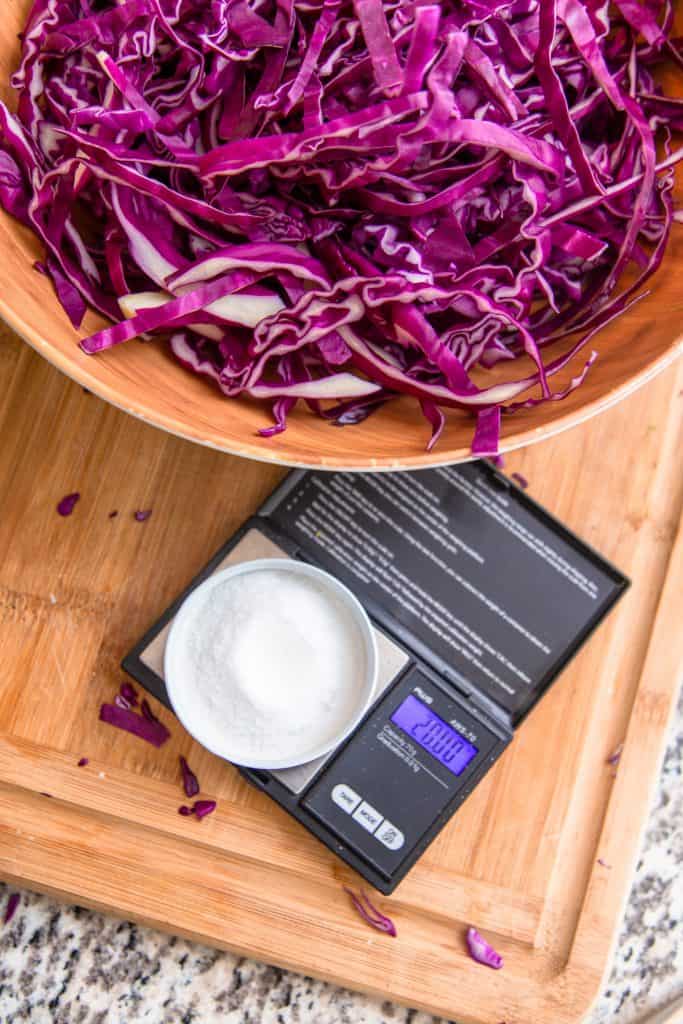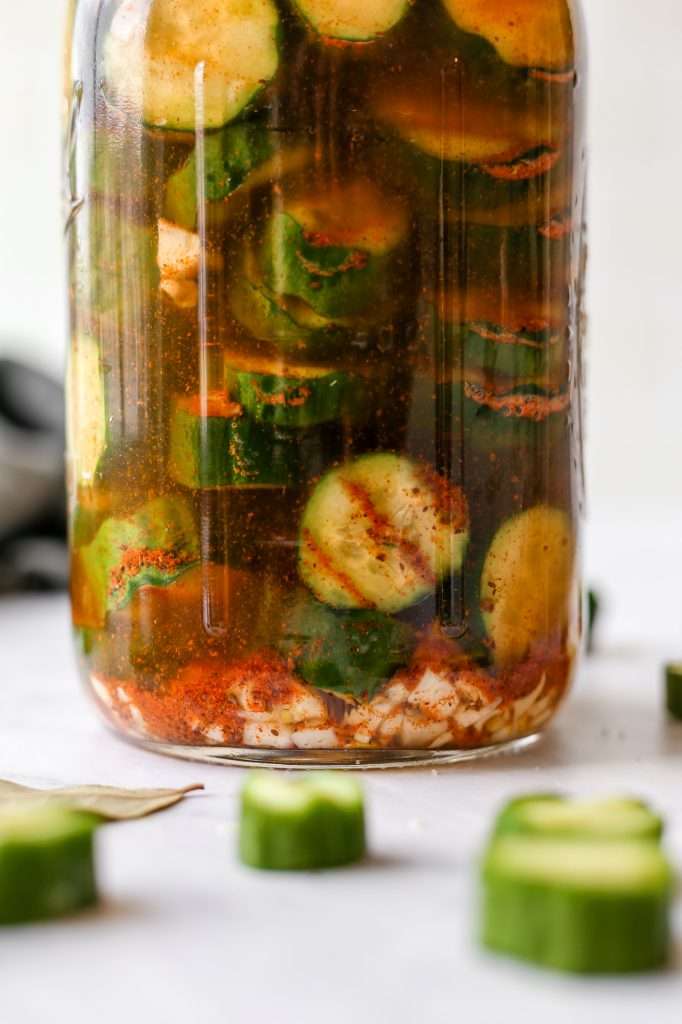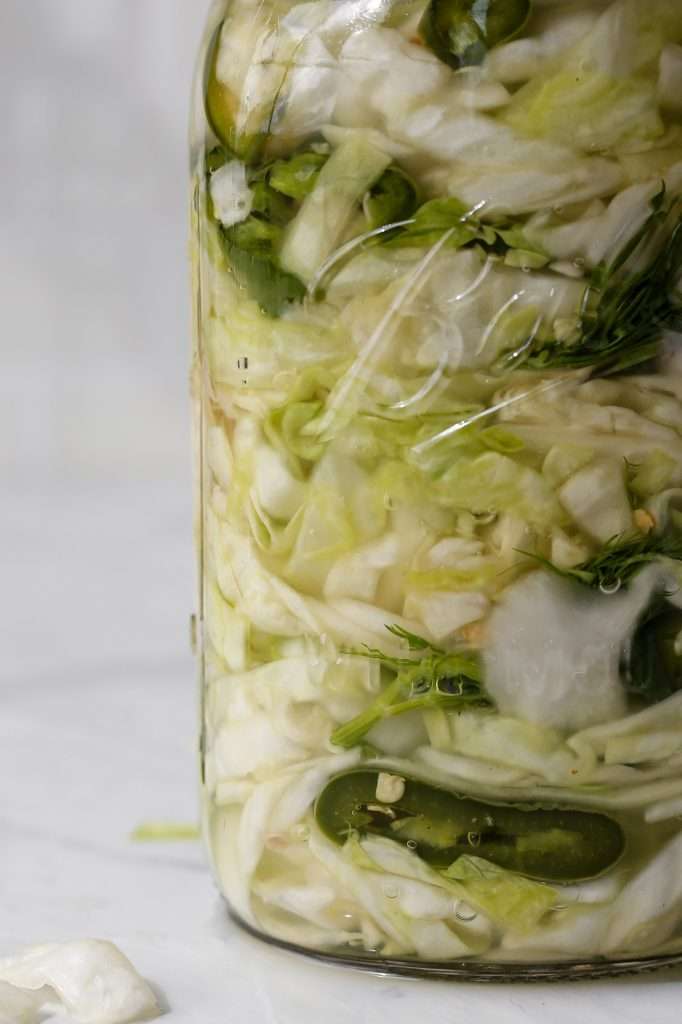The Five Most Common Vegetable Fermentation Mistakes
These mistakes can lead to sour flavors, inconsistent results, and unsafe fermentation projects.
- Not weighing your ingredients
- Using the wrong salt concentration
- Not keeping everything submerged
- Not fermenting for a long enough time
- Adding unnecessary ingredients
How to avoid the most common vegetable fermentation mistakes:
Weigh Your Ingredients
Do you have trouble achieving consistency across batches of fermented vegetables? It’s probably because you aren’t measuring your ingredients properly. For wild vegetable fermentation, all ingredients need to be measured in mass units, like grams.
When discussing fermenting vegetables, we specifically refer to a microbial process called lactic acid fermentation. This fermentation occurs when specific bacteria produce lactic acid by fermenting plant compounds for energy.
All it takes is the addition of a precise salt concentration to vegetables, and you can turn plain old produce into flavor-rich superfoods. We can only achieve an exact salt concentration is by measuring ingredients in mass units.
You can read all about using weight measurements in fermentation recipes here.
Use the Correct Salt Concentration
Not using the proper salt concentration is a significant cause of concern. Salt concentration controls microbial growth before lactic acid bacteria can produce acid to preserve the vegetables. Basically, salt roots for Leuconostoc bacteria to start thriving while discouraging yeasts from thriving. This leads to a quick and safe drop in pH.
A SPECIFIC salt concentration is VITAL and highly effective in controlling dangerous fungi, gram-negative bacteria, and the toxins they can produce.
Specific salt concentrations encourage the growth of desirable, beneficial microorganisms that rapidly and steadily decrease the pH and preserve the vegetables. These bacteria include Leuconostoc spp. and Lactobacillus spp.
If you’re looking for guidance on calculating and measuring salt concentrations, you can reference The Complete Guide to Safely Using Salt in Vegetable Fermentation.

Keep Everything Submerged
Certain microbes love oxygen; certain microbes love anaerobic environments. Oxygen levels directly influence which microbes thrive. Everything has to stay submerged in the liquid while fermenting.
Fungi will find a way to grow if all ingredients are not submerged in the liquid during fermentation. Fungi do undesirable things in vegetable fermentation. Some fungi produce toxins, and some can metabolize acids, increasing the pH and negating the preservation effects of lactic acid fermentation.
You can learn more about fermentation weights and the best jars for fermenting here.
Allow For a Long Enough Fermentation Time
Too short of a fermentation time robs you of so many beneficial postbiotic compounds. When given enough time, Lactobacillus spp. produce bioactive peptides and polyphenols that are wonderful for health.
Lactobacillus only start to thrive, metabolize, and produce their byproducts AFTER about 7-14 days of fermentation (this timeline can change with temperature, unique methods, and additional ingredients like that of cultural and traditional fermentation recipes).
So, being patient with fermentation projects is the way to go. Anything after seven days is probably okay to taste test, but I like my ferments right around 21-28 days for maximum health benefits.
If a moderate temperature (60-85° F) is maintained, I suggest refrigerating at 28 days for optimal sensory qualities and health benefits. Hotter temperatures can encourage fermentation to proceed much faster, so if fermenting is above 85° F, you may find your fermented vegetables done at 12-14 days.
Fermenting vegetables for a proper amount of time also influences biogenic amine (histamine) content. If Lactobacillus spp. are given enough time to thrive and metabolize, many of these species can degrade and decrease biogenic amines in all fermented foods.

Keep It Vegan If You Have Gut Issues
Just like eating many different vegetables influences the composition of your microbiome, fermenting different foods with different ingredients changes the structure of the microbial fermentation community.
Vegetables & fruits with ample sugars encourage yeasts to thrive, leading to excess alcohol production and possible acid metabolism by yeats. This metabolism can negate the preservative effects of fermentation.
Including animal products in fermentation, like whey and fish paste, can lead to microbial-produced biogenic amines. This can cause histamine reactions in some people.
I stick to vegan fermented vegetables only, and if I use fruit in fermented vegetables, the fruit does not make up more than 1/4 of the ingredients. You can read more about biogenic amines in fermented foods here.
A note on traditional and cultural fermentation recipes
Some traditional fermented foods, like baechu Korean kimchi and Dưa Chua Vietnamese fermented vegetables, have a swift fermentation time. This is thanks to specific ingredients and traditional methods.
Dưa Chua, for instance, is made by drying vegetables in the sun and then submerging them in a brine that includes salt and sugar. Dưa Chua is usually fermented for about 4 days at 80-95° F.
Baechu Korean kimchi is made by soaking nappa cabbage in a high-salinity brine for 12 hours before it is rinsed and rubbed with a paste made of salted shrimp, fish paste, gochugaru, sugar, ginger, garlic, and scallions. Then, it is packed into a fermentation crock and enjoyed after only three to seven days of fermentation.
In both examples, the ingredients, methods, and temperature are very important factors in the fermentation time and quality of the finished product.
If you want to make traditional fermentation recipes from other cultures, find a teacher from that culture who provides recipes (there are so many) and follow EVERY step, method, temperature, time, and ingredient. It is only fitting to respect the complexity of carefully developed traditional techniques.
Are You Interested In Making Fermented Foods At Home?
Try out these recipes:
- Roasted Garlic Sauerkraut with Black Pepper
- Fermented Dill Pickles
- Five Easy Fermented Vegetable Recipes for Beginners





















Hello..I made from fermented vegetable juice as a salad dressing, after fermentation I added a little raw apple cider vinegar and olive oil to it, but the mixture separated and did not mix
Is there a way to make it more homogeneous?
And what is the correct way to ferment lemon?
Salad dressings made like that will never fully mix… Since oil and water separate. You can put it in a bottle and shake it before using it.
I’ll see if I can put a salted preserved lemon recipe on our blog!
Hello. I love your website and recently started trying some fermentation projects. I used fermentation lids with a little nipple on top so I wouldn’t need to burp the jars. A lot of liquid escaped along with the gas and now my jars look dry. There does appear to be a layer of water remaining at the top of the jars but there are definitely air pockets that aren’t full of liquid. Will these ferments still be safe to eat?
they should be fine, but you might want to take those lids off, tamper everything down, and wash the lids well before you put them back on. Don’t worry about opening the jar and “letting oxygen in” (that doesn’t matter).
Hello!
Your blog is amazing!
I read an article* about pesticide residue in vegetables. It said that the fermentation processes leads to a reduction in pesticides levels and formation of new pesticides by-products. And the presence of pesticides may decrease the growth rate of fermentative microbiota. Also said that by washing the vegetables also reduce the levels of pesticides.
I live in Buenos Aires and it is sometimes difficult to purchase organic vegetables, is it possible to make a good fermentation with non organic foods by using some washing method ?
*https://www.sciencedirect.com/topics/medicine-and-dentistry/pesticide-residue
Thanks!
It is possible to make fermented foods with conventional produce and have good results. But pesticide and fungicide residues can harm the vegetable microbiome making fermentation difficult. Washing methods will not remedy this problem, because the problem is missing microbes. The best route to take is to ferment vegetables on the “clean 15” EWG list, like cabbage, and stay away from conventionally grown vegetables on the EWG dirty dozen list. If there is a farmers market or and small farm that locally grows produce you can buy from, these are good options even if its not “certified organic”
Kaitlynn
we grow a good many collards in our organic garden and I was wondering about fermenting them. Have you had any experience with Collards ? Also squash’s, zucchini, etc. Thanks!!!
I’ve mixed collards in with cabbage to make sauerkraut and it was really good!
Hello, I just found your website and am really liking the content. I’ll be using this as a reference going forward and have signed up for the newsletter. I’ve been fermenting cucumbers for about a year now, however, I’ve only let them sit for five to seven days. I guess I’m missing out on the good bacteria from what I’m reading. I’m going to do this again Friday and let it go for the 20-21 days. Thanks much, I can’t wait to try them!
You aren’t completely missing out with a 7 day fermentation. It’s still great for you, there are just more benefits (postbiotics) with a bit longer. Pickles usually only need 14 days total. 21 days is best for sauerkraut. you can find my pickle recipe here Fermented Cucumbers: Fermenting Sliced Cucumbers Two Ways
How to store and how long it is safe to eat fermented vegetable nutrition?